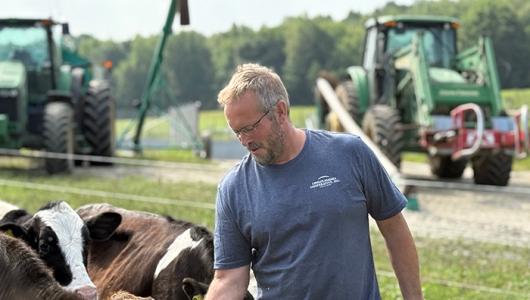In this Ask the Expert, Brett Gilland, County Executive Director for the USDA Farm Service Agency (FSA) in Harrison County, Missouri, answers questions about the Conservation Reserve Program (CRP). CRP is a popular, voluntary program that removes environmentally sensitive land from production in exchange for annual rental payments. Signup for the CRP General signup is currently open and closes July 23.
Brett is responsible for leading the farm program staff in his office. He’s very familiar with CRP personally and professionally. CRP is very popular in northwest Missouri, with more than 1,500 active CRP contracts in Harrison County alone. In his free time, you can find Brett on the family farm where he and his dad raise row crops, hay and cattle while also maintaining land they have enrolled in CRP.

How does the Conservation Reserve Program work?
CRP is a voluntary program that offers annual rental payments to producers in exchange for taking environmentally sensitive land out of production for a period of 10 to 15 years. Acreage that is accepted for CRP enrollment is planted to a cover of grasses or trees that reduces soil erosion and provides excellent wildlife habitat.
Who is eligible to participate?
Producers are eligible to offer land for CRP enrollment if they have owned or operated the land for at least 12 months prior to the end of the signup period. This requirement is waived if the acreage is currently in CRP and is being offered for re-enrollment. Producers must also meet certain FSA eligibility criteria to receive CRP payments, such as average adjusted gross income provisions.
Is my land eligible?
Land is eligible to be offered for CRP enrollment if it has been planted or considered planted to an agricultural commodity during at least four of the six crop years from 2012 to 2017. There are also some exceptions for cropland that was seeded to grass during that timeframe, as well as for land that was rotated between crops and grasses from 2006 to 2017. In addition to the cropping history requirements, land must also be physically and legally capable of being planted in a normal manner to an agricultural commodity. This means that the acreage must be free from brush and ditches and not be encumbered by any easements or other government programs that would prevent the producer from planting agricultural commodities.

How are CRP payments calculated?
CRP payments are calculated based on the number of acres enrolled multiplied by the per-acre rental rate of the contract. The rental rate is determined by the county the land lays in and the top three soil types of the acreage.
How do I submit a CRP enrollment offer?
To submit a CRP enrollment offer, you should contact your local FSA office to schedule an appointment. Before your appointment, secure a copy of the most recent deed for the acreage that you are offering as land ownership will need to be verified.
The CRP General signup is currently open, and it closes July 23. Additionally, the CRP Grasslands signup runs from July 12 through August 20, and FSA accepts applications year-round for the CRP Continuous signup.
How are CRP enrollment offers ranked?
Only CRP General and Grasslands are ranked. They use an Environmental Benefits Index (EBI) to rank all CRP offers in the nation based on six factors: wildlife habitat benefits, water qualify benefits, benefits from reduced erosion, enduring benefits, air quality benefits, and benefits per dollar of CRP rental payments. Each CRP offer receives an EBI point total based on these factors. After the signup period ends, FSA will analyze and rank all eligible offer based on a threshold set by the Secretary of Agriculture.
Some of the EBI factors can be controlled by the producer such as what type of cover will be planted, if wildlife enhancements will be offered, or if a rental rate is offered below the maximum rental rate. Other factors, such as where the land is located, how likely it is to erode, and what impact it will have on water and air quality cannot be controlled by the producer.
Is there anything new with CRP this year?
This year, FSA unveiled a number of improvements to CRP, including greater incentives for producers and increased its conservation benefits,.
Where can I find more information?
For more information, please visit the Conservation Reserve Program webpage. Enrollment is ongoing for CRP Grasslands and Continuous Enrollment.
USDA Service Centers are open for business by phone appointment only, and field work will continue with appropriate social distancing. While our program delivery staff will continue to come into the office, they will be working with producers by phone and using online tools whenever possible. All Service Center visitors wishing to conduct business with the FSA, NRCS, or any other Service Center agency are required to call their Service Center to schedule a phone appointment. More information can be found at farmers.gov/coronavirus.
Dana Rogge is a public affairs specialist with USDA. She can be reached by email at dana.rogge@usda.gov.


